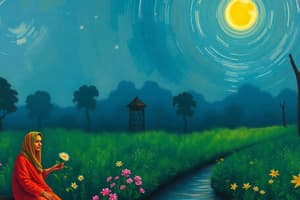Podcast
Questions and Answers
What policies were implemented during India's economic liberalization in the 1990s?
What policies were implemented during India's economic liberalization in the 1990s?
- Deregulation, privatization, and trade liberalization (correct)
- Sovereign default and closed borders
- Nationalization and increased government intervention
- Tax hikes and increased regulation
Which development contributed to increased food production and food security in India?
Which development contributed to increased food production and food security in India?
- Increased restrictions on farming practices
- Decrease in agricultural subsidies
- Implementation of food rationing
- Introduction of high-yielding varieties of wheat and rice (correct)
What major factor drove India's rapid population growth after independence?
What major factor drove India's rapid population growth after independence?
- Strict limits on family size
- High birth rates and declining mortality rates (correct)
- Government-led population control initiatives
- Mass emigration to other countries
In the context of women's rights in post-independence India, what does the Indian Constitution guarantee?
In the context of women's rights in post-independence India, what does the Indian Constitution guarantee?
What challenges persist in women's rights in post-independence India despite significant progress?
What challenges persist in women's rights in post-independence India despite significant progress?
What has been one of the notable outcomes for India after independence?
What has been one of the notable outcomes for India after independence?
Who became the first President of independent India?
Who became the first President of independent India?
Which act served as a temporary constitution for India until the new Indian Constitution was drafted?
Which act served as a temporary constitution for India until the new Indian Constitution was drafted?
On which date was the Indian Constitution adopted?
On which date was the Indian Constitution adopted?
What fundamental rights were guaranteed to Indian citizens by the Indian Constitution?
What fundamental rights were guaranteed to Indian citizens by the Indian Constitution?
During which period did India experience a government-controlled emergency declared by Prime Minister Indira Gandhi?
During which period did India experience a government-controlled emergency declared by Prime Minister Indira Gandhi?
Who presented the draft Constitution of India to the Constituent Assembly?
Who presented the draft Constitution of India to the Constituent Assembly?
Flashcards are hidden until you start studying
Study Notes
Post-Independence India
After centuries of British rule, India gained its independence on August 15, 1947. This period marked the beginning of modern India's political structure and societal developments. Here is a brief overview of key events and changes during this time:
Politics after Independence
Constituent Assembly
Almost immediately after independence, the Constituent Assembly was formed by representatives from all provinces to draft up a Constitution for India. On January 24, 1950, Dr. Rajendra Prasad became the first President of independent India. The draft Constitution of India was presented by Dr. B.R. Ambedkar on November 4, 1947.
Government of India Act
The Government of India Act of 1935 was used as a temporary constitution until the new Indian Constitution was drafted. This act was used to guide the country's administrative and political structure.
Indian Constitution
The Indian Constitution was adopted on January 26, 1950, which is now celebrated as a national holiday in India. The constitution guaranteed India's citizens fundamental rights, including the right to equality, freedom of religion, and cultural and educational rights.
Emergency
In 1975, India experienced an emergency period, which was a period of government control over all aspects of society and personal freedoms, declared by Prime Minister Indira Gandhi to suppress political opposition. The emergency lasted for 21 months until March 21, 1977.
Economic Liberalization
In the 1990s, India started a process of economic liberalization, opening up its economy to the world. This period saw the implementation of policies such as deregulation, privatization, and trade liberalization.
Societal Developments
Green Revolution
The Green Revolution was a period of agricultural transformation in the mid-20th century, during which scientists developed high-yielding varieties of wheat and rice. This led to increased food production and food security in India.
Population Growth
India's population grew rapidly after independence, reaching over 1.3 billion by 2011. This growth was driven by a high birth rate and falling mortality rates.
Women's Rights
The post-independence period also saw significant progress in women's rights in India, with the Indian Constitution guaranteeing gender equality. However, there are still challenges to overcome, such as high rates of domestic violence and unequal representation in the workforce.
Conclusion
Post-independence India has been a period of significant change and development for the country. From drafting a new constitution to implementing economic reforms and making strides in women's rights, India has faced various challenges and triumphs. Today, India stands as the world's largest democracy, with a rich cultural heritage and a burgeoning global role.
Studying That Suits You
Use AI to generate personalized quizzes and flashcards to suit your learning preferences.




